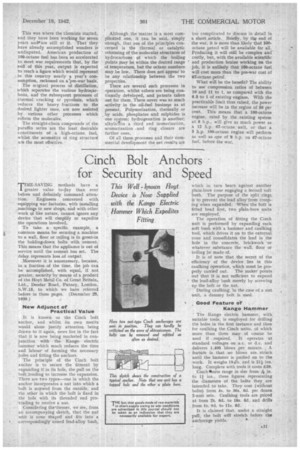Cinch Bolt Anchors for Security and Speed
Page 33

If you've noticed an error in this article please click here to report it so we can fix it.
This Well known Hoyt Device is Now Supplied with the Kongo Electric Hammer Which Expedites Fitting
TIME-SAVING methods have a 1 greater value to-day than ever before and definitely command attention: Engineers concerned with equipping war factories, with installing machines in new shops, and with other work of like nature, cannot ignore any device that will simplify or expedite the operations involved.
To take a specific example, a common means. for securing a machine to a wall, floor or ceiling is to grout-in the holding-down bolts with cement. This means that the appliance is out of service until the cement has set. The delay represents loss .of output.
Moreover it is unnecessary, because, in a fraction of the time, the job can be accomplished, with equal, if not greater, security by means of a product of the Hoyt Metal Co. of Great Britain, Ltd., Deodar Road, Putney, London, S.W.15, to which we have referred before in these pages. (December 2'3, 1939.)
New Adjunct of Practical Value It is known as the Cinch bolt anchor, and whilst its own merits would alone justify attention being drawn to it again, news lies in the fact that it is now being marketed in conjunction with the Kango electric hammer which much reduces the time and labour of forming the necessary holes and fitting the anchors. The principle of the Cinch bolt anchor is to secure the fitment by expanding it' in its hole, the pull on the bolt tending to increase the expansion. Them are two types—one in which the anchor incorporates a nut into which a bolt is sceewed from the outside, and the other in which the bolt is fixed in the hole with its threaded end protruding to receive a nut.
Considering theformer, we see, from an accompanying sketch, that the nut unit is cone shaped and fits into a correspondingly coned lead-alloy bush, which in turn bears against another plain-bore cone engaging a §econd soft bush. The purpose of the split rings, is to prevent the lead alloy from creeping when expanded. When the bolt is fitted head first, two plain-bore units arc employed.
The operation a fitting the Cinch emit is performed by expanding each soft bush with'a hammer and caulking tool, which drives it on to the external cone and consolidates the lead in the hole in the concrete, brickwork or whatever substance the wall, floor or ceiling he made of.
It is of note that the secret of the efficiency of the device lies in this caulking operation, which must be properly carried out. The maker points out that it is not sufficient to expand the lead-alloy bush merely by screwing up the bolt or the nut..
During caulking, in the case of .a nut unit, a dummy bolt is used.
Good Feature of Kango Hammer
The Kango electric hammer, with suitable tools, is employed for drilling the holes in the first instance and then for caulking the Cinch units, of which more than three may of course be used if required. It operates at standard voltages on ac. or d.c. and delivers 1,400 blows ,per minute. , A featuee is that no blows are struck until the hammer is pushed on to the work. It weighs 19elb. and is 21i ins. long. Complete with tools it costs £39.
Cinch nits range in size from elic to 11 ins., these figures representing the diameters of the bolts they are intended to take. They cost (without bolts) from 4s. to 36s. 6d. per dozen 2-unit sets. Caulking tools are priced at from n. 13d. to 18s. 6d. and drills from is. 9d. to lls. 8d.
It is claimed that, under a straight pull, the bolt will stretch before the anchorage yields.




















































